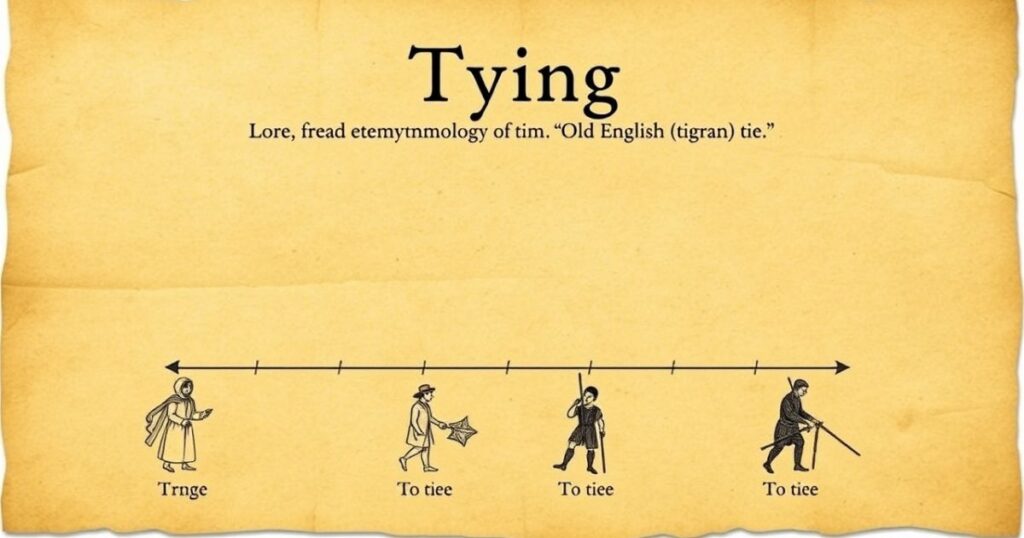The confusion between “Tying or Tieing” is common, and many people struggle with knowing which one is correct. Both words may seem similar, but only one of them is proper in English grammar. When we talk about the act of fastening something with a knot or string, the right choice is “Tying.” The term “Tying or Tieing” refers to the process of securing something, whether it’s your shoes, a rope, or any other object. Understanding the difference between “Tying or Tieing” is essential for using the word correctly in your writing.
So, when you’re wondering which word to use, remember that “Tying” is always the right option. While “Tieing” might seem like it makes sense, it’s actually a common mistake. Stick to “Tying” in your writing, and you’ll avoid confusion. Whether you’re tying your shoes or tying a knot, “Tying or Tieing” should always be “Tying.” Stay confident and use the correct form for clarity.
Why is There Confusion?

The confusion between “tying” and “tieing” is a common one in English, and it mainly arises from the application of the “I before E” rule and the way English words evolve. The word “tie” follows the typical rule of dropping the “y” and adding “ing” to form “tying,” while “tieing” is simply an incorrect variation that doesn’t fit with English spelling patterns. Examples:
- She was tying her shoes before the race started.
- The dog is tying its leash to the tree.
- He spent hours tying the knots to secure the tent.
This misunderstanding happens because some people mistakenly believe that “tie” should follow a different rule for forming the present participle. The correct form is “tying,” and while “tieing” might seem plausible, it’s simply not part of standard English usage.
“Tying” or “Tieing”: Which is Correct?
The confusion between “tying” and “tieing” often arises due to a misunderstanding of English spelling rules. In English, when verbs ending in “e” form their present participle, the “e” is dropped, and “-ing” is added. This pattern applies to most verbs, such as “make” becoming “making” or “dance” becoming “dancing.” However, with “tie,” the same rule applies, making “tying” the correct form.
“Tieing” is an incorrect variation, likely stemming from the misconception that it follows a different rule. It doesn’t fit with common English verb conjugation patterns and is considered a spelling mistake. Therefore, “tying” is the proper and widely accepted form.
Thus:
- The correct form is “tying”, as per the standard rule for verbs ending in “e” (dropping the “e” and adding “-ing”).
- “Tieing” is a common misspelling and does not follow typical English conjugation rules.
- Using “tying” ensures consistency with other similar verbs like “make” becoming “making” and “dance” becoming “dancing.”
Mastering these small spelling details can improve your writing and help avoid common errors. Remember, “tying” is the way to go when you’re referring to fastening something with a knot or cord.
Related Guide:
Writing or Writting: Never Get Confused Again
What Does “Tying” Mean?
“Tying” is the present participle of the verb “tie,” which means to fasten, secure, or bind something with a knot, string, rope, or similar material. It can also refer to the act of connecting or linking things together.
For example, “tying” can be used in different contexts:
- Physically fastening something: “She is tying her shoes.”
- Connecting two things: “The event is tying the community together.”
- In sports or games: “The score is tied, and the game is still ongoing.”
Overall, “tying” refers to the action of binding or linking things in various ways.
Words Following the -ie to -y Rule
| Base Word | Present Participle |
| tie | tying |
| pike | piking |
| excise | excising |
| abide | abiding |
| plie | plieing |
Synonyms of “Tying”
The word “tying” can be substituted with several synonyms depending on the context. Here are some examples:
- Binding: The act of securing something together, often using a material like rope or fabric.
- Fastening: Attaching or securing something in place.
- Securing: Ensuring something is safe or firmly in place.
- Knotting: Specifically referring to the act of tying a knot.
- Lacing: The act of tying or fastening something with laces, often in shoes or corsets.
- Attaching: Connecting or fastening one object to another.
- Connecting: Linking two or more things together.
- Stringing: The act of threading or tying something together with a string.
- Hitching: Tying or securing something, often used in relation to animals or vehicles.
- Roping: Tying with rope, especially in the context of securing livestock.
- Tethering: Attaching or securing something, typically an animal, with a rope or chain.
- Hooking: Attaching or securing something using a hook.
- Clipping: Using a clip to fasten or secure something.
- Linking: Connecting or joining things together in a series or chain.
- Conjoining: Joining or linking two or more things together.
Each of these synonyms can be used depending on the specific context of the action, whether it’s physical or metaphorical.
Sentences Using “Tying”
Here are some example sentences showcasing the use of the word “tying”:
- Tying her shoes, she was ready to leave for the jog.
- He was tying the ropes to secure the tent in place.
- Tying the leash to the tree kept the dog from running away.
- They are tying the boxes together to make moving easier.
- The sailor spent time tying knots to secure the sails.
- She’s tying a ribbon around the gift to make it look pretty.
- After tying her hair into a ponytail, she grabbed her gym bag.
- The artist spent hours tying together different colors to create balance.
- He was tying the boat to the dock so it wouldn’t float away.
- Tying the fence posts kept the structure from collapsing.
- Tying the final knot on the rope, he finished the climbing setup.
- The workers were tying the hay bales before storing them in the barn.
- Tying the knots tightly is crucial when securing the cargo.
- She spent the morning tying a scarf around her neck for warmth.
- Tying the loose threads together, she completed the tapestry.
These sentences demonstrate how “tying” is used in a range of situations, from practical to figurative actions.
Etymology of “Tying”

The word “tying” originates from the Old English word “tīgan,” which means “to bind or tie.” This word has roots in Proto-Germanic teugan, which also meant “to pull, draw, or tie.” Over time, the meaning of “tying” evolved to refer specifically to fastening or securing something with a knot or similar method. The transformation from “tīgan” to “tie” in Middle English led to the modern spelling we use today.
The suffix “-ing” was added to “tie” to form the present participle “tying,” following standard English conjugation rules for verbs ending in “e.” This structure allows the verb to describe an ongoing action or state. As language evolved, “tying” became a versatile term, applicable in various contexts, from physical actions to metaphorical connections.
FAQ’s
What is the correct spelling between Tying or Tieing?
The correct form is “Tying,” not “Tieing.” “Tying” is the proper way to describe the act of fastening or securing something.
Why is Tying used instead of Tieing?
The rule for verbs ending in “e” is to drop the “e” and add “ing.” This applies to Tying, not Tieing.
Is Tieing a common mistake in writing?
Yes, many people mistakenly use Tieing instead of Tying. It’s a common spelling error that can be avoided by following standard grammar rules.
Can I use Tieing in any context?
No, Tieing is incorrect in all contexts. Always use Tying when referring to fastening or securing something with a knot.
How can I avoid using Tieing incorrectly?
To avoid using Tieing, simply remember the rule for verbs ending in “e.” Always choose Tying when referring to the action of fastening something.
Conclusion
When it comes to “Tying or Tieing,” remember that “Tying” is always the correct form. “Tying or Tieing” is a common mix-up, but knowing the right choice will make your writing clearer. The confusion happens because both words look similar, but “Tying” is the standard way to describe the act of fastening or securing something with a knot. Whether you are tying your shoes or tying a knot, “Tying” is the only correct option to use.
So, always choose “Tying or Tieing” carefully in your writing. By using “Tying” instead of “Tieing,” you ensure that your sentences are grammatically correct. “Tying or Tieing” should never cause confusion once you know the proper way to use it. Stick with “Tying,” and your writing will be accurate and easy to understand. Remember, “Tying” is the key, so don’t worry about “Tieing” anymore.

Ember Rose is a dedicated administrator with 4 years of experience in efficient operations management and team leadership. Skilled in streamlining workflows and enhancing productivity.

